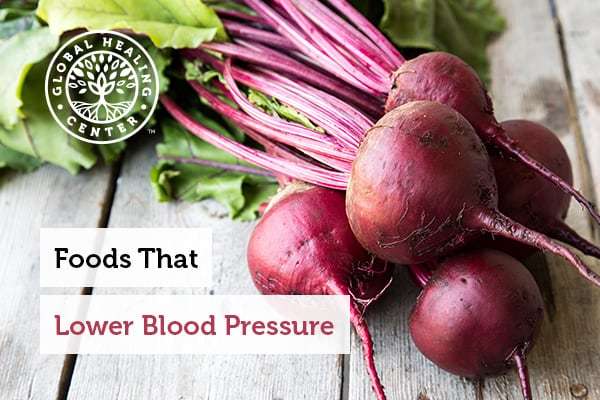Foods That Lower Blood Pressure

There is a virtual cornucopia of foods, herbs, and other forms of nourishment that are readily available to lower high blood pressure, or hypertension, naturally. Fruits, vegetables, and nuts are just a handful of the healthy things you can eat to promote healthy blood flow. Learning the benefits of these foods and determining which ones are best for your diet may help to lower your blood pressure and maintain circulatory health.
The Importance of Your Blood
"Blood is a very special juice," wrote the famous 18th-century author Johann Wolfgang von Goethe, but it is more than just “special.” Blood is the fuel that sustains human and animal life. It enables the body to stay alive by carrying oxygen and nutrients to living cells, taking away waste products, and transporting immune cells to fight infections. The average human adult body contains more than six quarts of blood which travels through the blood vessels and heart. This essential substance also includes platelets that can form a stopper in damaged blood vessels, preventing blood loss. As special as this “juice” is, it can also develop an unhealthy amount of pressure in your body.[1, 2]
What Is Blood Pressure?
Blood pressure is the pressure your blood applies to the walls of your blood vessels as it flows. Your heart is a muscle that works as a pump to push your blood through these vessels. Checking your blood pressure is one of the first tasks performed whenever you visit your healthcare professional.
Since it’s impossible to determine blood pressure merely by sight or listening to the heart, an oscillatory cuff is wrapped around the upper arm and inflated until blood flow is restricted. As the pressure slowly decreases, the cuff is able to detect vibrations. It measures your systolic reading when the pressure subsides just enough for the artery to force blood through. The cuff takes your diastolic reading when the pressure reduces further and your blood moves freely through your artery with its normal pulses.[3]
What Is High Blood Pressure & What Is Normal Blood Pressure?
Healthy or normal blood pressure is below 120/80 – 120 being the systolic level and 80 being the diastolic level. Most people tend to be right around these levels or slightly higher. The systolic level is the highest your blood pressure reaches when your heart beats, and the diastolic is the lowest it reaches as your heart relaxes. Sometimes these levels get too high due to complications stemming from diet, weight, activity levels, alcohol, smoking, and stress.[4]
There are varying degrees of blood pressure measured in five categories.[5]
- Normal: Systolic less than 120 and diastolic less than 80
- Elevated: Systolic between 120-129 and diastolic less than 80
- Stage 1 hypertension: Systolic between 130-139 or diastolic between 80-89
- Stage 2 hypertension: Systolic at least 140 or diastolic at least 90
- Hypertensive crisis: Systolic over 180 or diastolic over 120
Why Is High Blood Pressure Bad for You?
High blood pressure causes harm to your blood vessels. When blood pushes through your arteries with too much force, damage occurs and enables fat and calcium to build up. This process eventually causes blockage to occur in the form of plaque-promoting inflammation of the artery walls. Also known as clogged arteries, or atherosclerosis, this buildup may cause blood clots to form. These clots can sometimes break loose and find their way to the heart or lungs resulting in obstructed blood flow to these organs.[6]
There are several things you can do to help bring down your blood pressure levels.[7]
- Maintain a healthy weight
- Stop smoking
- Reduce or eliminate alcohol intake
- Raise activity levels
- Start an aerobic exercise routine
- Avoid stress and anger
- Incorporate relaxation techniques
- Follow a low-sodium diet
- Eat healthy foods rich in vitamins and nutrients that promote healthy arteries and blood flow
Foods That Lower Blood Pressure
Certain foods are rich in properties that can maintain strong blood vessels, discourage calcium deposits in healthy arteries, and promote healthy blood flow. Nutrients like potassium, calcium, and magnesium support a healthy circulatory system and have positive effects on blood pressure. The American Heart Association recommends the Dietary Approaches to Stop Hypertension (DASH) diet to maintain a healthy circulatory system. This plan suggests a diet rich in fiber, vegetables, fruits, lean meats, poultry, fish, whole grains, nuts, and beans. The DASH diet also encourages eating small amounts of low or nonfat dairy products and a low sodium intake.[8]
Veg Out
Researchers say that potassium-rich vegetables like sweet potatoes, avocados, kale, and spinach could help to lower your blood pressure and promote overall wellness. In a typical North American diet, sodium is dominant, and potassium is low. This imbalance can increase the chance of developing high blood pressure. Research revealed that people who ate more potassium experienced healthier blood pressure.
Nitrates are compounds that are also major players when it comes to lowering blood pressure. They play a significant role in our metabolic system. The body can convert them into a molecule called nitric oxide, which is related to blood flow. It allows the cells in your arteries to soften which can promote low blood pressure. The largest source of nitrates in the human diet is found in vegetables. The most potent and beneficial is beetroot. In addition to this powerful food, there are others rich in vitamins and minerals that help to lower blood pressure.[9]
- Broccoli
- Carrots
- Potatoes cooked in their skin
- Leafy greens such as Swiss chard and spinach
- Vegetable juices like carrot and tomato
- Acorn squash
- Beets
- Kale
Fresh & Fruity
Fruits are considered some of the best foods to lower blood pressure. Researchers have found that people who consumed fresh, raw fruits on a regular basis had substantially lower blood pressure than those who rarely ate them. Certain fruits provide minerals such as potassium and substances called flavonoids, both of which are linked to healthy blood pressure. The most potent of these are:[10]
- Bananas
- Oranges
- Apples
- Pears
- Grapes
- Raisins
- Fruit juices: prune, pomegranate, orange, apple
- Blueberries
- Strawberries
Blueberries and strawberries are particularly powerful. Research suggests that these may lower blood pressure by aiding in the blood vessels’ elasticity. Start off your day with a heart-healthy breakfast mixing these fruits in a cup of yogurt or bowl of oatmeal.[11]
Tea Time
Tea has been associated with a lowered risk of cardiovascular disease, and research suggests this herbal drink can lower blood pressure if consumed on a regular basis.
Hibiscus Tea
Many studies have evaluated this sour tea and its impact on blood pressure. Hibiscus tea contains antioxidants and has blood pressure-lowering abilities, especially in its extracts. In one particular study, adults who were mildly and pre-hypertensive showed a healthy reduction in their systolic levels after only six weeks of drinking hibiscus tea on a daily basis.[13]
Black Tea
Unlike other types of tea, black tea is more oxidized — a result of the leaves being aged longer. In the past, black tea has been shown to improve mental alertness and can promote and maintain healthy arteries. Studies indicate that consumption of four to five cups of black tea daily can reduce high blood pressure.[14, 15]
The Need for Seeds
One of the most dynamic foods for blood pressure health is a tiny brown seed called a flaxseed. In a 2013 study, patients who ate three generous tablespoons of flaxseeds a day for six months showed an impressive drop in their systolic blood pressure. These flaxseed servings can be eaten in many ways. Try baking them into bread products such as bagels and muffins, or use them in sauces and salad dressings.[16]
Sunflower seeds are another heart-healthy seed that may aid in lowering blood pressure. Rich in vitamin E, folic acid, protein, fiber, and a good source of magnesium, eating just a handful a day may help. To minimize your sodium intake, make sure to snack on unsalted seeds.[17]
Go Nuts
Potent sources of potassium, magnesium, and fiber, nuts are a great way to help lower blood pressure. They are a rich source of healthy omega-3 fatty acids which are needed to combat the unhealthier omega-6 fats. Some nuts can be high in this fat, so it is important to remember portion control. The nuts that contain higher amounts of omega-3 and lower amounts of omega-6 acids are walnuts, pistachios, hickory nuts, and cashews — making them optimal choices for helping with blood pressure reduction. Salted nuts, or nuts canned in oils, will not help lower blood pressure due to a higher sodium and fat content.[18]
Magic Beans
Beans are nutritious, versatile, and inexpensive. Full of excellent nutrients including potassium, fiber, and magnesium, beans are a great food to help lower blood pressure and improve overall heart health. A great way to enjoy beans is in salads, soups, or wraps. Choose dried or, if you can find them, fresh beans over the canned variety as they tend to lose some of their nutritional value. Here are some healthy bean choices for your diet.[19]
- Black-eyed peas
- Kidney beans
- Pinto beans
- Lentils
- Navy beans
- Chickpeas
Spice It Up
Adding a little spice to your life may be just what you need for healthy blood pressure. Most of the world’s population uses herbal supplements to support their health because they are easier for the human body to absorb and have fewer side effects. Extensive research has been done over the last few decades on the effect of plants on blood sugar, revealing promising results.[20]
Turmeric is one of the most vibrant and therapeutically significant spices available. It is a popular curry spice that has been used both in cooking and herbal remedies. The main molecule in turmeric is curcumin, which research shows has very impressive properties. A curcumin supplement can support the production of nitric oxide, a component that may help maintain healthy blood pressure.[21] Other spices and herbs that may support normal blood pressure are:
- Basil
- Cardamom
- Cat’s claw
- Cayenne pepper
- Cinnamon
- Garlic
- Nutmeg
- Rosemary
Oil Change
Cooking oils are used to fry foods, as salad dressings, and as a fat substitution during meal preparation. There are differences in oils and not all of them are a healthy choice. Changing out bad fats, or saturated and trans fats, for healthier fats – monounsaturated and polyunsaturated fats, can help lower cholesterol and blood pressure. When purchasing cooking oils, choosing “cold-pressed” and “expeller-pressed” versions are best as they retain all of the nutrients that would otherwise be hurt by a heating process. Out of all cooking oils, research showed that extra virgin olive oil has a greater positive effect on blood pressure.
Some oils lose nutritional value and can even be harmful at high temperatures. Oils with a more substantial amount of monounsaturated fat can withstand higher temperatures, while oils high in polyunsaturated fat are better as a dressing or as a fat substitute in recipes. Avocado oil is best for cooking and has a healthy omega-3 to omega-6 ratio. Flaxseed and olive oil are better left unheated. Olive oils, however, can still be used for cooking at a lower heat.[22]
Sweetest Thing
Extensive research shows that dark chocolate is "good for you," and people are taking this information to heart. Its high flavonoid content is what makes this treat so beneficial. These flavonoids are at their highest amounts in the cocoa solids of the cocoa bean which are found in darker chocolates. They can contain 46 to 60 milligrams of catechin, (a type of flavonoid) in just one ounce.[23]
Artificial sweeteners aren’t a healthy substitute for sugar, but Stevia may be a safe choice. It is a natural sweetener derived from the leaves of a plant found in the sunflower family. Stevia is a nice alternative to sugar because it is plant-based and is much sweeter than sugar, allowing for smaller servings. Some research shows that it might help lower blood pressure due to glycosides found in the extract.[24, 25]
Foods To Avoid
Trying to achieve a healthy blood pressure isn’t just about eating heart and blood-healthy foods, it's also about knowing which foods to stay away from. Sodium and sugar are the biggest contributors to high blood pressure. Since most pre-packaged foods contain heavy amounts of these, a fresh, more natural diet is encouraged. Also, many types of food have heavier levels of sodium, like certain dishes found on a Chinese or Italian food menu. Here are some foods to consider avoiding.[26]
- Processed foods
- Foods with a high sodium content
- Fast foods (even their “low fat” menus)
- Frozen seafood
- Bacon
- Deli meats
- Canned or bottled tomato products like ketchup and red pasta sauces
- Canned soups
- Energy drinks
- Pizza
- Alcohol
- Tobacco products
Some research suggests that small portions (about the size of a deck of cards) of lean beef are acceptable as part of a DASH-like diet.[27] However, because red meat may be toxic to your colon, vegan and vegetarian diets are a better strategy for encouraging healthy blood pressure.
Additionally, while omega-3 fatty acids, like linolenic acids found in fish, have been linked to heart health, it’s better to get those nutrients through vegan alternatives due to the high levels of mercury that are found in many types of seafood.[28]
Here’s To Your Health
Staying healthy isn’t always easy, but keeping your blood pressure down with healthier foods is something to consider regardless of your blood pressure levels. Not only does a fresh, balanced diet promote healthy arteries, it contributes to healthy weight maintenance and overall wellness. Eating healthy isn't enough, though. Daily exercise can help contribute to normal blood flow and lead to a healthier heart. It is recommended to do an aerobic workout of 30 to 45 minutes five days a week. It is not necessary to get those minutes packed into one workout, so feel free to break it up into ten-minute sessions throughout the day. A heartier 20-minute-a-day workout three days a week is also beneficial. Walking, jogging, biking, and swimming are a few good choices and can make a big difference on your path to health.
What’s Your Story?
References (28)
- Goethe, J. W., & MacIntyre, C. F. (1957). Goethe's Faust, part 1: New American version. New York: New Directions.
- Dean, L. "Blood Groups and Red Cell Antigen." Bethesda (MD): National Center for Biotechnology Information (US); 2005. Web. 25 Oct. 2017.
- "Oscillatory Blood Pressure Monitoring Devices." PMC. BMJ 20 Oct 2001. Web. 25 Oct. 2017.
- "Understanding Blood Pressure Readings." American Heart Association. heart.org. 15 Nov. 2016. Web 26. Oct. 2017.
- "New ACC/AHA High Blood Pressure Guidelines Lower Definition of Hypertension." American College of Cardiology, 13 Nov. 2017.
- Bennett, M. "All about blocked arteries." British Heart Foundation. Heart Matters Magazine, n.d. Web 25 Oct. 2017.
- "Hypertension and Nutrition." Cleveland Clinic, 2017. Web 25 Oct. 2017.
- "Nutrition and healthy eating." Mayo Clinic, 08 April 2016. Web. 25 Oct. 2017
- "Beating high blood pressure with food." Harvard Medical School. Harvard Health Publishing. harvard.edu. Oct. 2010. Web. 25 Oct. 2017.
- "Eating more fruit may help lower blood pressure." Harvard Medical School. Harvard Health Publishing, Feb, 2016. Web. 25 Oct. 2017.
- "Eat blueberries and strawberries three times per week." Harvard Medical School. Harvard Health Publishing, July 2013. Web. 25 Oct. 2017.
- McKay, D.L., Chen, C.Y., Saltzman, E., Blumberg, J.B. "Hibiscus sabdariffa L. tea (tisane) lowers blood pressure in prehypertensive and mildly hypertensive adults." J Nutr. Feb 2010;140(2):298-303. Epub 16 Dec 2009. Web. 25 Oct. 2017.
- McKay, D.L., Chen, C.Y., Saltzman, E., Blumberg, J.B. "Hibiscus sabdariffa L. tea (tisane) lowers blood pressure in prehypertensive and mildly hypertensive adults." J Nutr. Feb 2010;140(2):298-303. Epub 16 Dec 2009. Web. 25 Oct. 2017.
- "Brewing evidence for tea's heart benefits." Harvard Medical School. Harvard Health Publishing. harvard.edu. 19 Jun. 2015. Web. 25 Oct. 2017.
- Greyling, A., Ras, R.T., et al. "The Effect of Black Tea on Blood Pressure: A Systematic Review with Meta-Analysis of Randomized Controlled Trials." PLoS One. 2014; 9(7) e103247. Web. 25 Oct. 2017
- "Eating flaxseed may lower blood pressure." American Heart Association. heart.org. 5 Nov. 2012. Web 25 Oct. 2017.
- Ros E, et al. "Consumption of Plant Seeds and Cardiovascular Health: Epidemiologic and Clinical Trial Evidence." Circulation. 2013; 128(5): 553–565. Web. 25 Oct. 2017.
- Ros E. "Nuts and novel biomarkers of cardiovascular disease." The American Journal of Clinical Nutrition. ajcn.nutrition.org. 25 Mar. 2009. Web. 25 Oct. 2017.
- Bell R., et al. "Dried beans lower cholesterol and glycated hemoglobin while peas lower blood pressure in adults with mild hypercholesterolemia." The Federation of American Societies for Experimental Biology. The FASEB Journal Online. 2017; 31(1). Web. 25 Oct. 2017.
- Tabassum, N., Ahmad, Feroz. "Role of natural herbs in the treatment of hypertension." Pharmacogn, Rev. Jan-Jun 2011; 5(9): 30–40. Web. 26. Oct. 2017.
- Yao Y., et al. "Curcumin Exerts its Anti-hypertensive Effect by Down-regulating the AT1 Receptor in Vascular Smooth Muscle Cells." Sci Rep. 2016; 6: 25579. Web. 26 Oct. 2017.
- "Healthy Cooking Oils." American Heart Association. heart.org. 14 Nov. 2016. Web. 25 Oct. 2017.
- Rostami, A., Khalili, M., et al. "High-cocoa polyphenol-rich chocolate improves blood pressure in patients with diabetes and hypertension." ARYA Atheroscler, Jan 2015;11(1):21-9. Web. 26 Oct. 2017.
- "Stevia." U.S. National Library of Medicine. MedlinePlus. medlineplus.gov. 29 Jun. 2016. Web. 26 Oct. 2017.
- Ulbricht C., et al. "An evidence-based systematic review of stevia by the Natural Standard Research Collaboration." Cardiovasc Hematol Agents Med Chem. Apr. 2010;8(2):113-27.
- Pendic, D. "Sodium still high in fast food and processed foods." Harvard Medical School. Harvard Health Publishing. harvard.edu. 16 May. 2013. Web. 26 Oct. 2017.
- Clifford J, et al. "Understanding the DASH Diet – 9.374." Colorado State University. Extension. colostate.edu. Nov. 2015. Web. 26 Oct. 2017.
- Menon S. "Mercury Guide." National Resources Defense Council. 10 Mar. 2016. nrdc.org. Web. 26 Oct. 2016.
†Results may vary. Information and statements made are for education purposes and are not intended to replace the advice of your doctor. If you have a severe medical condition or health concern, see your physician.

Dr. Edward Group, DC
FOUNDER | HEALER | ADVOCATEDr. Group, DC is a healer and alternative health advocate, and an industry leader and innovator in the field of natural health who is dedicated to helping others. He is a registered doctor of chiropractic (DC), a naturopathic practitioner (NP), and proud alum of Harvard Business School and MIT Sloan School of Management. Dr. Group, DC is the founder of Global Healing – a mission and vision he has shared through best-selling books and frequent media appearances. He aims to spread his message of positivity, hope, and wellness throughout the world.











